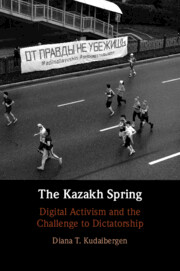Book contents
- The Kazakh Spring
- The Kazakh Spring
- Copyright page
- Dedication
- Contents
- Figures
- Tables
- Acknowledgements
- Introduction
- 1 What Is the Kazakh Spring?
- 2 Who Are Oyan, Qazaqstan?
- 3 Deconstructing Vlastʼ
- 4 Performing the State, Performing the Protest
- 5 Generation Q and Decolonizing Alash
- 6 The Public Square and the Body under Authoritarian Pressures
- 7 Queering the Public Sphere
- 8 Making Sense of the Bloody January 2022 Mass Protests
- Conclusions
- References
- Index
4 - Performing the State, Performing the Protest
Published online by Cambridge University Press: 16 May 2024
- The Kazakh Spring
- The Kazakh Spring
- Copyright page
- Dedication
- Contents
- Figures
- Tables
- Acknowledgements
- Introduction
- 1 What Is the Kazakh Spring?
- 2 Who Are Oyan, Qazaqstan?
- 3 Deconstructing Vlastʼ
- 4 Performing the State, Performing the Protest
- 5 Generation Q and Decolonizing Alash
- 6 The Public Square and the Body under Authoritarian Pressures
- 7 Queering the Public Sphere
- 8 Making Sense of the Bloody January 2022 Mass Protests
- Conclusions
- References
- Index
Summary
This chapter discusses the Kazakh Spring's context of digital revolution. In the absence of viable, independent media, the protestors had to move their communication, outreach, and engagement online. Kazakhstan is one of the most digitalized post-Soviet nations, and the Kazakh Spring managed to politicize this and help the emergent protests even on less politicized platforms like Instagram. This was exacerbated by the public health crisis and growing corruption of the first pandemic year. Political protestors were involved in creating databases of Covid deaths that the state tried to hide and created a space not only for digital national mourning but also for investigation of the corruption associated with the Covid crisis. Through these processes, Kazakh Spring activists were able to unite many citizens whom this crisis left angry and disoriented in the conditions. This chapter also focuses on the online trial of activist Asya Tulesova in August 2020, which had to be held on Zoom due to the lockdowns.
- Type
- Chapter
- Information
- The Kazakh SpringDigital Activism and the Challenge to Dictatorship, pp. 134 - 168Publisher: Cambridge University PressPrint publication year: 2024

